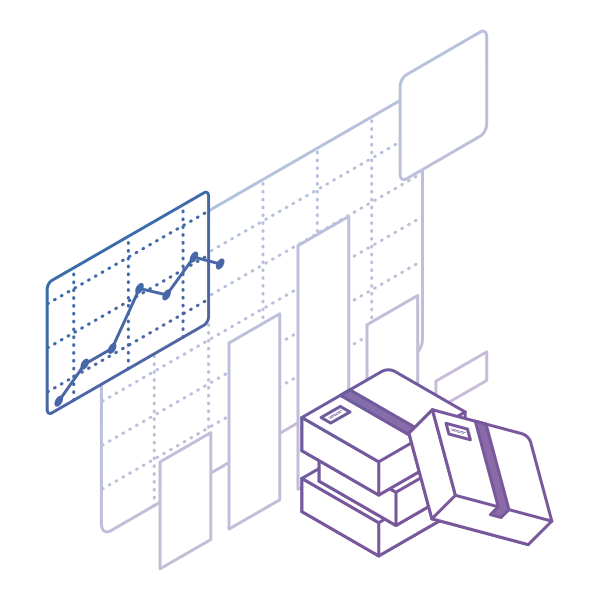Managing portfolio epics and features in Kanban can be challenging, especially when dealing with multiple teams working on interconnected tasks. In a typical Portfolio Kanban setup, epics reside on a portfolio kanban board and are broken down into user stories that are distributed across various team boards. This approach offers excellent visualization and transparency, but it can also lead to significant challenges, particularly when teams need to synchronize their work.
How to Manage Portfolio Epics in Kanban?
As discussed, in a standard Portfolio Kanban implementation, epics are tracked on a portfolio kanban board, while the corresponding user stories are handled on separate team boards. For instance, imagine a scenario where a single portfolio kanban board features an overarching initiative, such as a "Product Development Program," with three separate team boards: one for the Design team, another for the Mechanical Engineering team, and a third for the Quality Assurance (QA) team. This structure is visualized in the example below:
 Visualizing an epic at a portfolio level connected to three teams' boards in Businessmap
Visualizing an epic at a portfolio level connected to three teams' boards in Businessmap
This setup significantly enhances visualization and transparency across the organization. However, there is a critical issue that is often overlooked as teams progress through their work: a form of waste known as "scatter."
Understanding Scatter and Its Impact
Scatter refers to actions or inactions that disrupt the flow of knowledge and information, rendering them ineffective. In practical terms, this means that in most companies, the Design team may have little to no knowledge of what the Mechanical Engineering or QA teams are doing. Teams tend to operate in silos, with limited awareness of activities outside their own board.
This siloed approach might not be problematic when teams are working on different Agile epics. However, as soon as two or more teams begin collaborating on the same epic, the situation changes dramatically - and often for the worse.
Consider a scenario where four teams are working on the same epic, and each team is responsible for contributing a single user story. If you were to measure the cycle times for each story and compare them to the cycle time of the entire epic, you might find a significant discrepancy. For example:
| Item |
Cycle Time |
| User Story #1 |
12 days |
| User Story #2 |
7 days |
| User Story #3 |
9 days |
| Epic |
28 days |
You might wonder how it is possible that the sum of the user story cycle times is only 28 days (approximately one month), yet the epic took four months to complete.
This is a prime example of scatter. Information and knowledge become so dispersed across the teams that the flow at the portfolio kanban level is severely disrupted. This disruption often results from synchronization issues, miscommunication, expedited stories, and other similar challenges.
Addressing Scatter with Flow Efficiency
To effectively combat the issue of scatter and enhance the flow of work across teams, it’s crucial to focus on a metric known as flow efficiency. Flow efficiency is a measure of how much time spent on a task is value-adding compared to the total cycle time. In simple terms, flow efficiency is the ratio between value-adding time and total cycle time.
Value-adding time includes any period during which active work is being performed - essentially, any time that is not spent waiting or blocked. For example, if it takes 8 hours to complete a task, but you only spend 2 hours actively working on it during the day, the flow efficiency would be 25%, calculated as follows:
»Process Cycle Efficiency[%] = (Value-Added Time / Cycle Time)*100«
To fully understand and improve flow efficiency, it’s important also to define and consider the non-value-adding components: Wait Time and Block Time.
-
Wait Time: Wait time is the period during which a card on your kanban board is waiting for something. This could be waiting for approval, feedback, or any other dependency. Waiting is one of the most common sources of waste in many companies, as it can significantly delay progress.
-
Block Time: Block time refers to the duration when a card is in a blocked state, meaning it cannot move forward in the workflow due to an issue. Common scenarios include defects, lack of necessary resources, or insufficient team capacity. When a task is blocked, it halts the entire process, leading to inefficiencies.
To refine the flow efficiency calculation by accounting for these factors, we adjust the value-added time as follows:
»Value-Added Time = Cycle Time – Wait Time – Block Time«
Optimizing Flow Efficiency at the Portfolio Level: 3 Key Scenarios
When measuring flow efficiency at the portfolio level, the fundamental formula remains the same. However, the definitions of wait time and block time become more complex due to the varying scenarios that can occur when dealing with multiple user stories.
Scenario 1: All User Stories Must Be Executed Sequentially
In this scenario, the wait time is any delay between the completion of one user story and the start of the next. Additionally, any block in one of the user stories directly impacts the cycle time of the entire epic, making it block time for the epic as well. Consequently, any wait time at the user story level accumulates as wait time for the entire epic.

Scenario 2: All User Stories Can Be Executed in Parallel
When all user stories can be executed in parallel, the ideal cycle time for the entire epic should match the cycle time of the longest user story. Here, non-value-adding time is calculated as the difference between the actual cycle time of the epic and the cycle time of the longest user story.

Scenario 3: Some User Stories Must Be Executed Sequentially, while Others Can Run in Parallel
This scenario, which is the most common in practice, resembles the principles of Critical Chain Project Management (CCPM). The following considerations apply:
- Any delay in starting a user story that cannot begin until another is completed is considered wait time.
- Any block in a non-parallel story is counted as block time.
- Any block in the longest parallel story also counts as block time.
- A block in a parallel story that is not the longest may or may not be considered block time, depending on whether it can be "hidden" behind the longest story.
- Any wait time at the user story level adds to the wait time for the entire epic, provided those stories are on the "critical path."
By carefully analyzing these scenarios, you can more accurately measure flow efficiency at the portfolio level, leading to better management of epics and improved synchronization across teams.
The Importance of Managing Flow Efficiency in Complex Portfolios
Consider a real-world scenario where an R&D department is managing over 50 epics, broken down into more than 200 user stories, spread across 5+ teams. This creates a challenging environment where it's easy for things to get lost in the shuffle, and delays become the norm. Often, no one has a clear picture of the progress or the reasons behind the slow completion of tasks.
Without managing flow efficiency at the Portfolio Kanban level, inefficiencies abound. For example, a team might begin work on the first story of a new epic, unaware that another epic could have been completed sooner had they known its status.
This lack of synchronization can result in significant delays and wasted effort. However, by focusing on flow efficiency at the portfolio level, organizations can dramatically improve their processes, often leading to greater overall efficiency.
A real-world example of this can be seen in Aerosud's Engineering department. Seeking greater agility, they implemented flow management using Businessmap's software and Kanban at the portfolio level. By visualizing workflows across different service groups and adopting the "Flight Levels" concept, they tackled a major issue: the lack of transparency within their IT services area. This approach not only enhanced visibility but also significantly boosted project management efficiency, demonstrating the powerful impact of managing flow efficiency in complex portfolios. (Aerosud case Study)
 Visualizing workflows of different service groups on a portfolio kanban board in Businessmap
Visualizing workflows of different service groups on a portfolio kanban board in Businessmap
Businessmap is the most flexible software
to align work with company goals
In Summary
Tracking and managing the flow of portfolio epics is crucial for ensuring successful and efficient work processes. By measuring flow efficiency at the Portfolio Kanban level, you can:
- Improve process cycle efficiency.
- Accurately distinguish and measure data across different workflow structures.
- Identify and address blockers that slow down the entire work process.





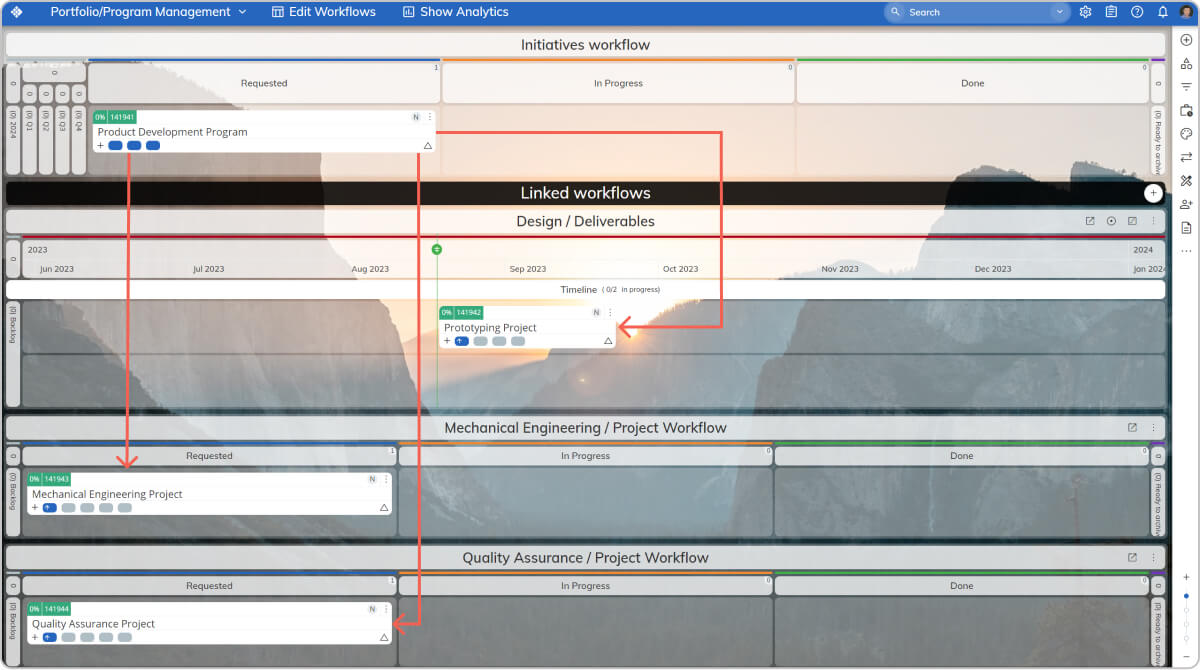 Visualizing an epic at a portfolio level connected to three teams' boards in Businessmap
Visualizing an epic at a portfolio level connected to three teams' boards in Businessmap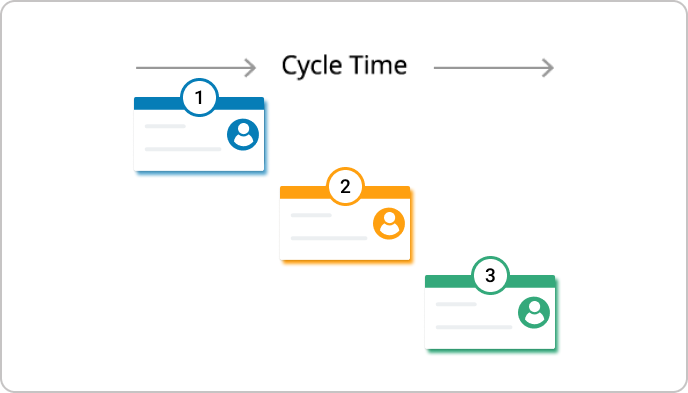
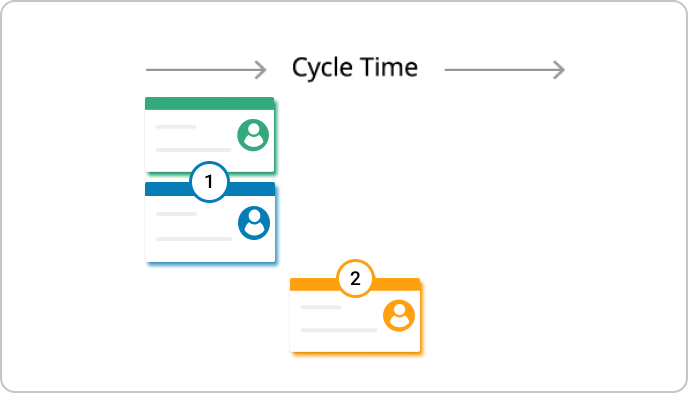
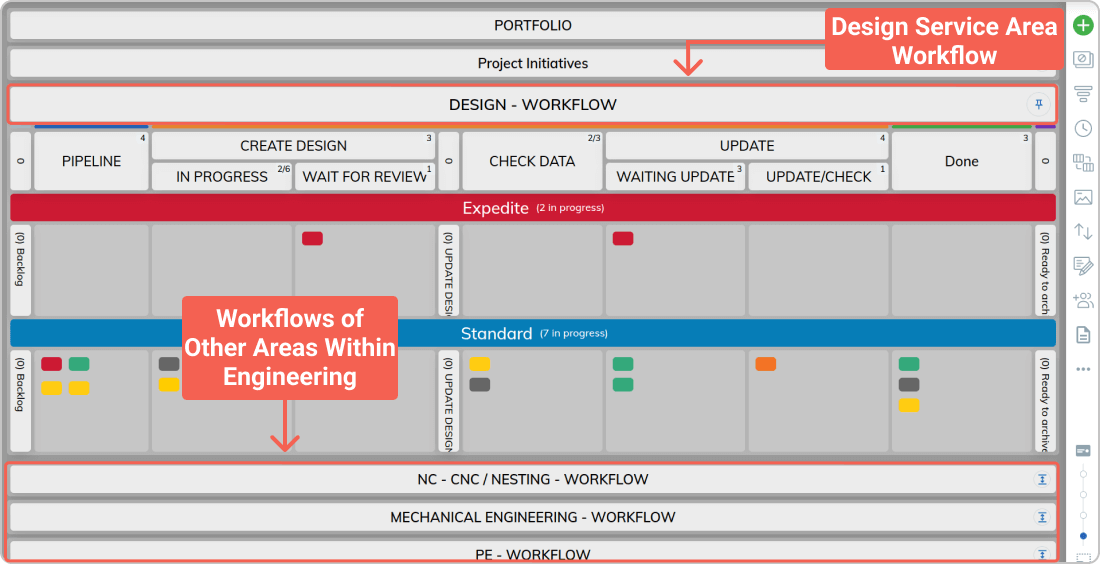 Visualizing workflows of different service groups on a portfolio kanban board in Businessmap
Visualizing workflows of different service groups on a portfolio kanban board in Businessmap


